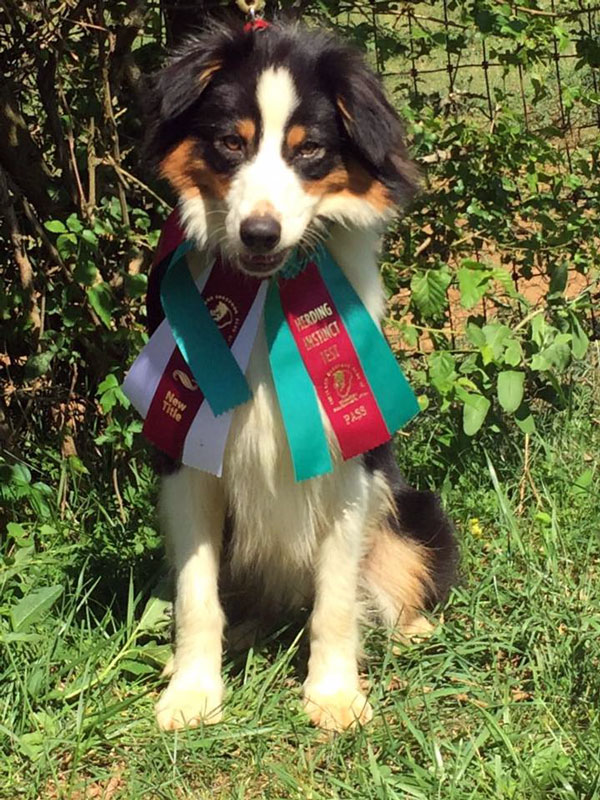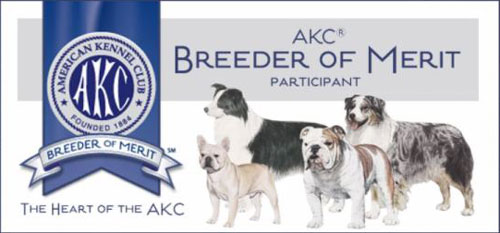About Australian Shepherds
The Australian Shepherd was developed in the 19th and 20th centuries as a general-purpose ranch and farm dog in the American West, where a tough, enduring, versatile stockdog with an honest work ethic was required.
His usual work included moving very large herds of sheep and cattle from summer to winter grazing grounds and back, flushing range cattle out of heavy brush, and moving livestock in tight quarters such as chutes and alleys.
These kinds of jobs are still where Australian Shepherds excel and are most valued.
Breed Standards
Height: 20-23 inches (male), 18-21 inches (female)
Weight: 50-65 pounds (male), 40-55 pounds (female)
Temperament: Smart, Work-Oriented, Exuberant
Life Expectancy: 12-15 years
Group: Herding Group

Color
The recognized colors are blue merle, red (liver) merle, solid black, and solid red (liver) all with or without white markings and/or tan (copper) points with no order of preference. The blue merle and black have black pigmentation on nose, lips and eye-rims. Reds and red merles have liver pigmentation on nose, lips and eye rims. On all colors the areas surrounding the ears and eyes are dominated by color other than white. The hairline of a white collar does not exceed the point at the withers.
Working Description
The Australian Shepherd is categorized as one of the Loose-Eyed breeds of stockdogs. He is a confident, authoritative worker with a unique style that differs from Strong-Eyed breeds. He is agile, upright and close-working, and exhibits these distinctive traits while maintaining the ability and versatility to control all types of livestock in an efficient and deliberate manner. The Australian Shepherd excels at controlling large and/or slow- moving flocks of sheep and herds of cattle, and is highly regarded for his superior ability to effectively manage livestock in tightly confined spaces. The Australian Shepherd is powerful and intense by nature easily learning the appropriate force and distance needed for the type of livestock being worked. Utilizing a loose-eyed approach to stock, a working Australian Shepherd will often display wear, grip, and/or an authoritative bark, as well as eye when necessary, to handle their stock.
Personality And Character
Those of us who love Aussies can t imagine a more perfect breed of dog. Unfortunately, the very characteristics we value in these dogs make them unsuitable for some homes and owners. Consider carefully if your lifestyle can accommodate the exuberance of a typical Aussie.
The Australian Shepherd was developed to be a moderate sized, intelligent, all-purpose stock dog of great character and endurance. Many Aussies today still do the work they were bred for, and even those that have never seen sheep or cattle usually have a strong herding instinct. This means that Aussies need fenced yards and leashes, as the temptation to herd dogs, children, and traffic can simply overwhelm them.
Being bred to work hard all day means that most Aussies are not content to be couch potatoes, although Aussies have individual characters and some are more sedate and quiet-natured than others. For the most part, however, these are high energy dogs who need a purpose in their lives-a job as it were. Owners must be committed to give these dogs the time and attention they require through play and training, for as with any dog, undirected energy can turn towards destructive behaviors such as digging and chewing. Running, jumping, and rough-housing are all a part of being a normal Aussie.
The great intelligence of these dogs, necessary to out-think and control livestock, can be detrimental when left untrained and unused. Aussies are quite capable of out-thinking their owners. Obedience training is highly recommended as a means of teaching owners how to channel the typical Aussie s innate desire to please into appropriate behaviors. Aussies learn very quickly, so be certain you are willing to keep your Aussie occupied with walks, play, and training to benefit both mind and body.
Although many Aussies are friendly with everyone, the Australian Shepherd as a breed tends to be somewhat reserved and cautious around strangers. With Aussies of this nature, owners should encourage the dog to meet people but not force encounters. Aussies are often quite protective of their family and property, a desirable trait in some situations but not acceptable in others, and some dogs never accept strangers. As with all dogs, poorly socialized Aussies may become aggressive without proper training.
Aussies are generally healthy dogs and can be expected to live up to 12 years or more, so ownership can be a lengthy commitment. Although minimal, there is some grooming required to keep the coat clean and conditioned, such as regular brushing and nail trimming. To maintain their high energy levels, typical active Aussies may eat more than other more sedate dogs of similar size, so be prepared to feed plenty of high quality food.
However, Aussies are perfect for people wishing to own a highly trainable, versatile, super-smart dog that can work/play till the cows come home . If you have the time and commitment for an Aussie, you won t be disappointed. These special dogs deserve special owners. Their loyalty, drive, character, and whimsical sense of humor place them in a class by themselves.
Grooming
DAILY OR WEEKLY BRUSHING: Brushing your dogs coat is the single most important key in maintaining their coat and keeping their skin healthy and the body comfortable. Australian Shepherds are moderate to heavy shedders and keeping the dead, shedding coat removed not only stimulates the skin to keep it healthy but also allows the coat to properly protect the dog from the weather. A properly brushed coat insulates from both heat and cold by holding a layer of temperate air close to the body while keeping high heat or cold on the outer surface of the coat. Leaving the undercoat in prevents this process as it eliminates room for temperate air to be held. Some opt to have their dogs shaved instead. Keep in mind that shaving a double coated breed does NOT reduce shedding, it only sheds smaller hairs. It also may or may not grow back normally and completely removes the coats ability to insulate the dog from heat or cold.
Brushing your dog can easily be done with a good slicker brush and a long tooth undercoat rake. Using the brush first, brush with the direction of the coat. Gently use the undercoat to check to be sure the coat is well brushed down to the skin. Where you find tangles or resistance for the rake due to undercoat, work on those areas further with the brush. The undercoat rake should be used to get into the coat then comb slightly outward from the body rather than scraping it across the skin.
Professionally groomed Aussies should easily be able to be maintained with only monthly grooming, even if you choose to never brush your dog between grooming. Find a groomer you are confident is knowledgeable about the breed.
If you prefer to groom your dog yourself, you can find a do it yourself dog wash salon where you can take your dog, use their equipment to bathe, dry and groom your dog (though few will offer you shears or clippers, they do usually provide brushes and combs). The advantage to these is you get to leave the mess of bathing behind and most offer tubs at a comfortable height to bathe in rather than bending over your tub at home.
CREDITS
For more information on the Australian Shepherd Breed we urge to you visit The Australian Shepherd Club of America and The American Kennel Club.

